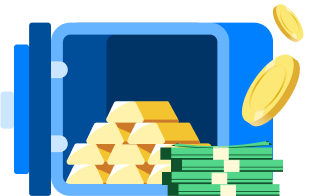
Table of Contents
Modified On:
Understand the repo rate and its effect on borrowing costs and inflation. Learn how central banks use this rate and check the current repo rate for insights into economic trends.
The repo rate is a tool used by central banks worldwide to regulate the supply of money in the economy. In India, the repo rate is set by the Reserve Bank of India (RBI).
The change in repo rate impacts lending and deposit rates for banks and non-banking financial companies (NBFCs).
It is important to stay updated with the current repo rate of the country, as it influences the EMI rates and saving returns.
What is Repo Rate?
The repo rate is the interest rate at which commercial banks borrow money from the RBI for short-term loans.
The name "repo" is derived from "repurchase option rate." This means that when banks borrow from the RBI, they commit to repurchasing the securities they sell back to the RBI at a later date.
As a result, the repo rate is used by the RBI to manage liquidity and keep inflation under control.
For example, if a commercial bank needs funds for everyday operations, it can borrow from the RBI at the current repo rate.
If the repo rate is high, banks' borrowing costs rise, potentially resulting in higher interest rates for consumers and companies.
Learn about the roles and functions of the RBI.
How Does Repo Rate Work?
The repo rate directly influences the cost of borrowing for banks. When the RBI changes the repo rate, it impacts the interest rates at which commercial banks lend to businesses and individuals. Here's how it works:
- Increase in Repo Rate: When the RBI increases the repo rate, it becomes costlier for banks to borrow money. This leads to higher lending rates for consumers and businesses, discouraging borrowing and spending, which can help curb inflation.
- Decrease in Repo Rate: When the RBI lowers the repo rate, borrowing becomes cheaper for banks, which may lead to lower interest rates for consumers and businesses. This encourages borrowing and spending, helping to stimulate economic growth.
Who Decides the Repo Rate?
The RBI's Monetary Policy Committee (MPC) decides the repo rate. The MPC has six members: three appointed by the government and three appointed by the RBI.
These members meet every two months to assess the status of the economy and determine the appropriate repo rate depending on variables such as inflation, economic growth, fiscal deficit, and exchange rates.
What is the current repo rate in India?
As of April 9, 2025, the repo rate in India stands at 6%. The RBI reduced the repo rate by 25 basis points from the previous 6.25% during the recent MPC meeting.
RBI Governor Sanjay Malhotra announced the new repo rate after MPC’s first meeting in FY26 that took place between April 7 and April 9.
This decision reflects the RBI’s ongoing efforts to balance economic growth with inflation control.
Save money in digital gold with just ₹10 on Jar App.
What is Reverse Repo Rate?
The reverse repo rate is the opposite of the repo rate. It is the rate at which the RBI borrows funds from commercial banks.
In this instance, banks temporarily deposit excess cash with the RBI and earn interest at the reverse repo rate.
Repo Rate vs. Reverse Repo Rate
Conclusion
A country's financial environment is heavily influenced by its repo rate. It has an impact on everything from loan interest rates to inflation control, making it an important instrument for the RBI to manage the economy.
Consumers, businesses, and anybody involved in financial planning must track and understand fluctuations in the repo rate.
Keep up with the latest economic developments and their implications for your financial decisions. The current repo rate of 6% reflects the RBI's commitment to promoting growth while keeping inflation under control.

Save Money in Digital Gold

.svg)








.png)
.png)












.jpg)

